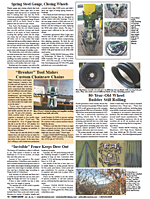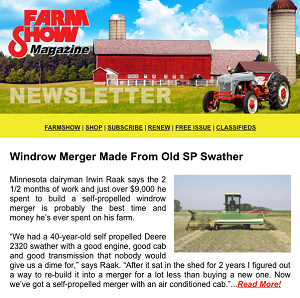Riding Mower Powered By V-8 Gas Engine
"It's quiet and comfortable to operate," says Don Robinett, Randall, Kan., about the riding mower he built that's equipped with an all-aluminum V-8 gas engine out of a 1962 Buick Special car. The engine powers three separate hydraulic motors mounted on the 6-ft. wide mower deck.
Robinett paid $250 for the Buick at an estate sale. He removed the engine and mounted it backward, keeping the two motor mount cross members as well as the cross member that supported the transmission. He bolted a stub shaft onto the crankshaft and used a 12-in.double groove pulley to belt-drive two hydraulic pumps. One pump powers the motors on the deck and the other powers a pair of hydraulic motors that drive the 18-in. front wheels. He used 3116-in. sheet metal to fashion the deck and sides of the mower and lighter weight sheet metal to make a flip up engine hood.
"It's so quiet that I can listen to a tractor radio mounted next to the seat while I mow," says Robinett." I use it to mow 3 to 4 acres of lawn as well as weeds around my grain bins. I wanted a big engine that could operate at lower rpm's without making a lot of noise. The engine runs at only 1,800r pm's compared to 3,000 rpm's for engines on conventional mowers. I used the car's muffler to keep engine noise to a minimum.
"GM made the Buick Special for three years, from 1961 to 1963. The engine block weighs only 62 lbs. - about half the weight of the block on a cast iron engine. I can lift the entire engine by myself. It has 252 cu. in. which isn't a lot for a V-8, but it has plenty of power even at 1,800 rpm's. However, running the engine slow causes the fan to turn slow so I had problems with the engine heating up. I had to buy a heavy-duty special-built radiator with four rows of tubes instead of two. I also locked up the fan's clutch - by drilling a hole through it and inserting a pin - so it always turns at the same speed as the engine.
"I flip a toggle switch next to the seat to activate a solenoid valve that engages the hydraulic motors. I use a pair of levers in front of the seat to control the drive wheels. By running one wheel forward and one backward at the same time I have zero turning radius. The 6-in. wide rear caster wheels are mounted on an oscillating axle which helps when going over bumps. I use a pair of hydraulic cylinders connected to parallel link age to raise the deck as much as 12 in., which lets me mow 6ft. tall wild sunflowers.
"The mower goes 8 mph on the road. I spent $3,100 for parts and $300 for each motor. Total cost was just under $5,000.
"The deck has three 24-in. blades that overlap 1 in. so it has a 70-in. cut. The grass clippings go straight through from front to back. I welded fins under the deck so the blades can't transfer clippings to each other. I didn't want side discharge because a 6-ft. deck would have left a big windrow. The hydraulic motors are bidirectional and are each equipped with two quick coupler hoses that lead to the pump - one pressure and one return. By switching the hoses I can reverse the motors so that the blades run in the opposite direction. The blades are flat and are sharpened on both sides so ! can run them backward and get twice as much use out of them before resharpening.
He mounted an oil cooler and air intake screen (the sieve off an old Mersey Harris combine) in front of the radiator. The air intake screen keeps grass clippings from being sucked into the radiator.
Contact: FARMS SHOW Followup, Don Robinett, Rt 2, Box 52, Randall, Kan. 66963 (ph 785 739-2468).

Click here to download page story appeared in.
Click here to read entire issue
riding Mower Powered By V-8 Gas Engine ENGINES Engines 18-3-10 "It's quiet and comfortable to operate," says Don Robinett, Randall, Kan., about the riding mower he built that's equipped with an all-aluminum V-8 gas engine out of a 1962 Buick Special car. The engine powers three separate hydraulic motors mounted on the 6-ft. wide mower deck.
Robinett paid $250 for the Buick at an estate sale. He removed the engine and mounted it backward, keeping the two motor mount cross members as well as the cross member that supported the transmission. He bolted a stub shaft onto the crankshaft and used a 12-in.double groove pulley to belt-drive two hydraulic pumps. One pump powers the motors on the deck and the other powers a pair of hydraulic motors that drive the 18-in. front wheels. He used 3116-in. sheet metal to fashion the deck and sides of the mower and lighter weight sheet metal to make a flip up engine hood.
"It's so quiet that I can listen to a tractor radio mounted next to the seat while I mow," says Robinett." I use it to mow 3 to 4 acres of lawn as well as weeds around my grain bins. I wanted a big engine that could operate at lower rpm's without making a lot of noise. The engine runs at only 1,800r pm's compared to 3,000 rpm's for engines on conventional mowers. I used the car's muffler to keep engine noise to a minimum.
"GM made the Buick Special for three years, from 1961 to 1963. The engine block weighs only 62 lbs. - about half the weight of the block on a cast iron engine. I can lift the entire engine by myself. It has 252 cu. in. which isn't a lot for a V-8, but it has plenty of power even at 1,800 rpm's. However, running the engine slow causes the fan to turn slow so I had problems with the engine heating up. I had to buy a heavy-duty special-built radiator with four rows of tubes instead of two. I also locked up the fan's clutch - by drilling a hole through it and inserting a pin - so it always turns at the same speed as the engine.
"I flip a toggle switch next to the seat to activate a solenoid valve that engages the hydraulic motors. I use a pair of levers in front of the seat to control the drive wheels. By running one wheel forward and one backward at the same time I have zero turning radius. The 6-in. wide rear caster wheels are mounted on an oscillating axle which helps when going over bumps. I use a pair of hydraulic cylinders connected to parallel link age to raise the deck as much as 12 in., which lets me mow 6ft. tall wild sunflowers.
"The mower goes 8 mph on the road. I spent $3,100 for parts and $300 for each motor. Total cost was just under $5,000.
"The deck has three 24-in. blades that overlap 1 in. so it has a 70-in. cut. The grass clippings go straight through from front to back. I welded fins under the deck so the blades can't transfer clippings to each other. I didn't want side discharge because a 6-ft. deck would have left a big windrow. The hydraulic motors are bidirectional and are each equipped with two quick coupler hoses that lead to the pump - one pressure and one return. By switching the hoses I can reverse the motors so that the blades run in the opposite direction. The blades are flat and are sharpened on both sides so ! can run them backward and get twice as much use out of them before resharpening.
He mounted an oil cooler and air intake screen (the sieve off an old Mersey Harris combine) in front of the radiator. The air intake screen keeps grass clippings from being sucked into the radiator.
Contact: FARMS SHOW Followup, Don Robinett, RI 2, Box 52, Randall, Kan. 66963 (ph 785 739-2468).
To read the rest of this story, download this issue below or click
here to register with your account number.








